| Parallel Lines and Proportional Parts |
|
|
| |
| For the first two problems, fill in the blanks. |
|
|
| |
| |
|
| |
|
| |
|
| |
|
| |
|
| Triangle Mid-segment Theorem |
|
|
| |
| |
|
| |
|
| On paper, graph triangle TUV with vertices T(2,2), U(6,12), and V(10,8), and then answer the next four questions. |
|
|
| |
| |
|
| |
|
| 10) Are segments XY and UT parallel? Support your answer by discussing the slopes of both segments. |
|
4000 character(s) left
Your answer is too long. |
|
|
Attachments |
|
| 11) Determine the lengths of segment XY and UT using the distance formula. Do these lengths verify the Triangle Mid-segment Theorem? Support your answer by comparing the lengths of both segments. |
|
4000 character(s) left
Your answer is too long. |
|
|
Attachments |
|
| Activity: Use a compass and straight edge to illustrate Corollary 21-A-2. Make four equal divisions on ray NP starting at point N. Name the four points where the arcs cross ray NP as points Q, R, S, and T with point Q being closest to point N. Draw segment TM. Continue on to construct three lines that are parallel to segment TM and pass through points Q, R, and S. Name the points where the lines cross segment MN as points X, Y, and Z with point X being closest to point M. |
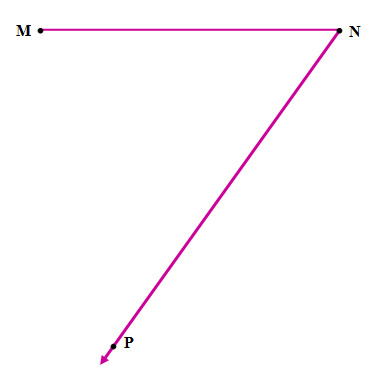 |
|
| |
| 12) Answer the following questions about the previous activity: (a) Name the congruent segments constructed on ray NP. (b) Name the congruent segments that were cut by the parallel lines on segment MN. |
|
4000 character(s) left
Your answer is too long. |
|
| |
|
| Refer to the figure below to answer the next three questions. |
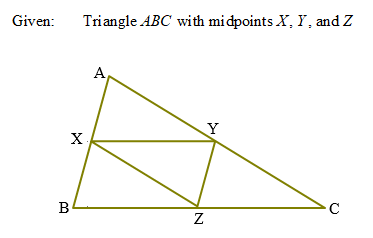 |
|
| |
| 13) What segment is parallel to segment XZ? Provide a reason why the lines are parallel. |
|
4000 character(s) left
Your answer is too long. |
|
|
Attachments |
|
| 14) Name one parallelogram. Provide a reason why the figure you named is a parallelogram. |
|
20000 character(s) left
Your answer is too long. |
|
|
Attachments |
|
| 15) Name one trapezoid. Provide a reason why the figure you named is a trapezoid. |
|
4000 character(s) left
Your answer is too long. |
|
|
Attachments |
|
| Corollaries about Parallel Lines |
|
|
| |
| For the next two problems, fill in the blanks. |
|
|
| |
| |
|
| |
|
| Refer to figure and the information below to answer the next six questions. |
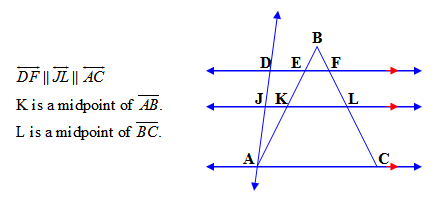 |
|
| |
| |
|
| |
|
| |
|
| |
|
| |
|
| 23) True or False? The statement below can be determined based on the given information. |
 |
|
|
| |
|
| For the next two questions, refer to the figure below and the following scenario: The length of the entire upper side of a custom-designed window is 315 m. The lines that divide the glass into sections are parallel. The lengths of the bottom of each section are shown in the figure. |
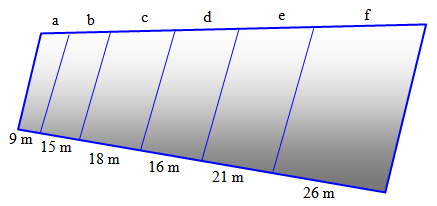 |
|
| |
| |
|
| 25) What are the lengths of each of the divisions on the upper side of the glass window? (In other words, what are the values of a, b, c, d, e, and f?) |
|
4000 character(s) left
Your answer is too long. |
|
| |
|
| Proportional Relationships of Parts of Similar Triangles |
|
|
| |
| For the next five problems, fill in the blanks. |
|
|
| |
| |
|
| |
|
| |
|
| |
|
| |
|
| 31) True or False. When two triangles are similar, the lengths of their corresponding medians, angle bisectors, and altitudes are proportional to the lengths of the corresponding sides. |
|
|
|
| |
|
| |
|
| 33) In the figure below, the medians of similar triangles DEF and KLM measure 42 and “x”, respectively. Solve for “x”. State the theorem that can be applied to solve the problem. |
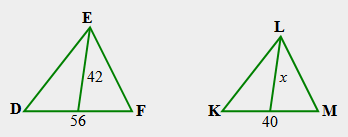 |
4000 character(s) left
Your answer is too long. |
|
|
Attachments |
|
| 34) In the figure below, segments DF and MP are angle bisectors and triangles CDE and LMN are similar. Solve for “x”. State the theorem that can be applied to solve the problem. |
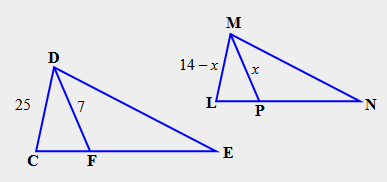 |
4000 character(s) left
Your answer is too long. |
|
|
Attachments |
|
| 35) Solve for “x”. State the theorem that may be applied to solve the problem. |
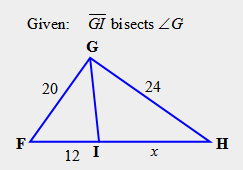 |
4000 character(s) left
Your answer is too long. |
|
|
Attachments |
|
| 36) Explain what must be true about the figure below to state that "IN/NL = JN/NM". |
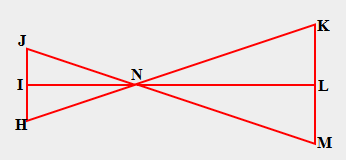 |
4000 character(s) left
Your answer is too long. |
|
|
Attachments |
|
| 37) The figure below is a Sierpinski triangle. Iteration, a process of repeating the same procedure over and over again, is used to create the design. Study the triangle closely and explain, using the geometry that you’ve learned in this unit and previous units, what iteration is used to create this special triangle. |
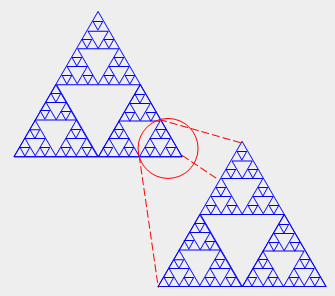 |
4000 character(s) left
Your answer is too long. |
|
|
Attachments |
|
| Extended Research: Check with your instructor to see if he/she is interested in awarding extra credit to you for writing a one-page report on the following research topic: Write a one page report about “fractals”. Some related points to research are: Sierpinski’s Triangle, naturally occurring fractals, computer-generated fractals, the Koch snowflake, the Hilbert curve, and self-similar shapes. You may include pictures that you find. Be sure to report all websites or other resources that you referenced to compile your report. |
|
|
| |
| Extended Activity: Check with your instructor to see if he/she is interested in awarding extra credit to you for completing the following activity: In the figure below, the first three steps of “Koch’s snowflake” has been created. Research the internet for more information on “Koch’s curve” or “Koch’s snowflake”. First, draw a large equilateral triangle and trisect each of its sides as shown in Step 1 below. Next, create the design in Step 2 by erasing the middle segment and replacing it with two segments that are the same length as the segment removed and positioned as shown. Continue on to repeat the process for all sides of the equilateral triangle. You should now have a 6 pointed star that is a dodecagon (12-sided polygon). Repeat the previous steps for each of the twelve edges. Your shape should begin to look like a snowflake. For a more detailed “snowflake”, repeat steps 1 and 2 one more time for each of the edges of the polygon you now have. Send your “Koch’s snowflake” to your instructor through email or regular mail. Some electronic ways to send this assignment is to fax the drawing or take a digital picture of it or scan it, and then send it through email. |
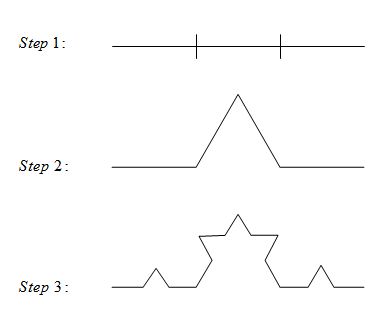 |
|
| |
| 38) If you were directed by your school to complete Offline Activities for this course, please enter the information on the Log Entry form. |
|
| No offline activities found |
0 Hour(s) & 0 Minute(s)
|
|
|
Attachments |
|